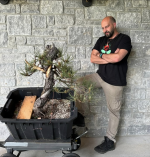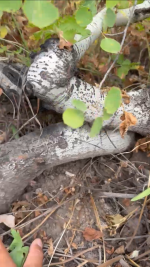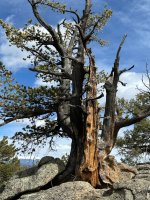Keep in mind I havent read all of the replies, so much of this may be redundant.
You need to collect a lot of roots if you want a high success rates with pines, and you cannot bare root them either. Your best bet is to find rock pockets where you can just about pull on the tree and it moves a lot, then find the large roots, and/or tap root that have escaped into a crack and cut only those. When I say a lot of roots, I mean almost all of the trees roots if possible, not just 3 or 6 inches from the base. Survival is your goal, not squeezing it into a bonsai pot. That will be a goal for 2-5 years down the road generally (I have two 1 seed juniper collected from New Mexico that had been in wooden boes for 9 years without a repotting when I bought them), but only after it has produced a more dense root system closer to the base which will allow for a reduction.
You'll need a lot of pumice to pot them in. A course, fine mix (doesn't leave the soil overly airy, and a very fine pine bark helps as well (the decomposition will keep the roots warmer as well which encourages root growth). A wooden box, or plastic tub, with as much drainage drilled into the bottom as possible but still capable of holding soil, that will accommodate all of the roots. The tree needs to be very very very well secured into the container. I cannot repeat this enough how important this step is. You want zero movement of the roots when you move the tree, or a heavy wind blows. Every time it moves it will effect the roots negatively if not.
I wouldn't dig anything nice to start with, the trees that are going to get murdered around your mine are a good place to start as you are going to murder them anyways. Learn all you can about caring for whatever species you plan to collect before hand, and continually study them afterwards. Learning the horticulture side of bonsai is more important than anything you can do.
I know the major tree collectors in the US dig this time of year in the mountains. Vince at Satoyama Bonsai is one of my best friends and he talks to me daily, as well as sends me photos and videos of his collections and uncollectible trees that are amazing...just to make me jealous.
Here's a year and a half of growth...you want this kind of vigor before you repot, or style, or do much of anything.
Photo from when Mauro Stemberger styled it in the spring of 2024, Mauro for size reference. Note the huge tub, this shows you how much roots were collected with the tree.
View attachment 612278
And yesterday while I was fertilizing this Ponderosa Pine.
View attachment 612276
This tree is vigorous enough it can handle a root reduction and move to a bonsai pot, and has been in the tub for about 4 years now.
Trees in cracks, or with very few roots like the two below are beautiful to look at, and would make rediculous bonsai, BUT they are not collectible and must be left alone.
View attachment 612279
View attachment 612280What you want are trees in rock pockets, where the roots have been contained in what could best describe as a natural container, or depression in the rock which keeps the roots near the tree, like this Rocky Mountain Juniper.
View attachment 612281
Speaking of Aspen, he sent me some videos of some gnarly old aspen the other day as well. Keep in mind if you plan to collect aspen. They are well known for sharing root systems with the surrounding aspen, so they may not have roots of their own to survive on.
View attachment 612282
View attachment 612283

















